OK, I’m going to cheat a little here. So far, I’ve been covering the Disney anim-anthology movies in the order they were released. But an interesting thing about the series of Disney anim-anthologies that went from 1942 to 1949 is that they can be divided into pairs. We’ve already seen that there were two that tried to educate US audiences about South American cultures and celebrate them. Then Disney made an animated anthology that could be and has been described as a “poor man’s Fantasia,” using dialogue and forms of music besides classical. Then they made one that was less of a “package feature” and more of a “double feature,” consisting of two stories clocking in at around forty minutes, each of which had at some point been planned as a feature length movie. Then they made another “poor man’s Fantasia.” Then they made another “double feature.” And then the company made Cinderella (1950) and would not do another anim-anthology for decades. To me, writing about the entries in the series that paralleled each other in the same blog posts makes the most sense even if it means jumping back and forth in the chronology a little bit.
Why was Disney doing so many of these during the 40s? Well, I don’t entirely understand it myself.[1]Perhaps I should have tried to explain this in the last post, but I also had to explain about the Good Neighbor policy thing, and this isn’t supposed to be a blog about history. I thought it … Continue reading Their more artistically ambitious animated films had underperformed at the box office. They’d lost some of their best talent after a bitter strike and more talent had been drafted into World War II. Those that remained had to make propaganda movies. The anim-anthologies were apparently cheaper to make and training ground, of sorts, for artists returning from war to get back in the zone. You can guess from that that most of these aren’t the most visually appealing cartoons out there, but every now and then these movies manage to dazzle while working under their admitted limitations.
Make Mine Music (1946)[2]Don’t ask me what the title means.
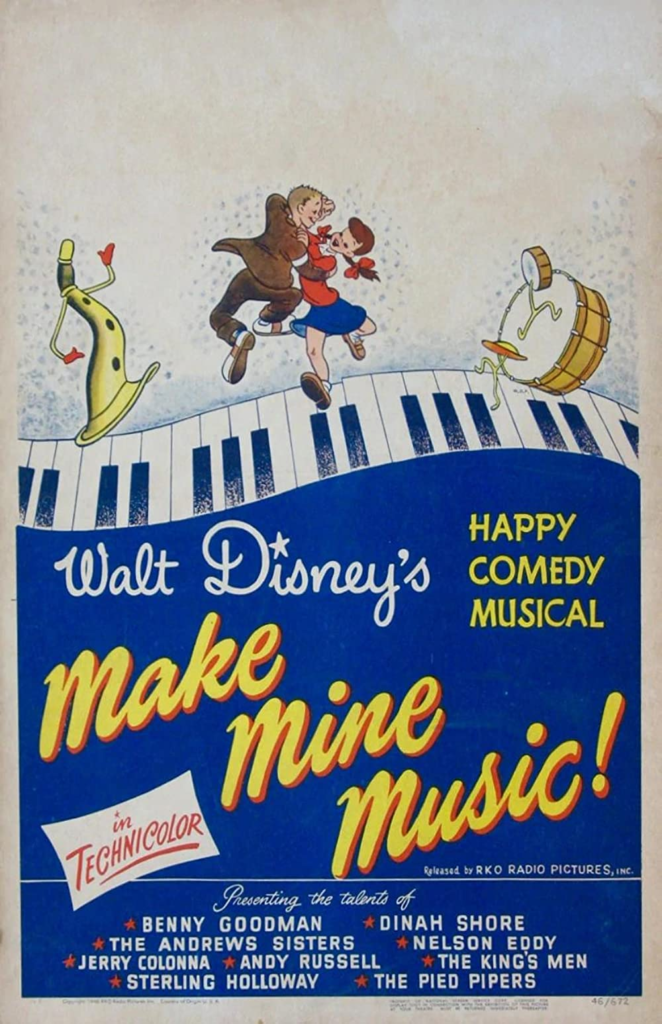
I didn’t describe the opening credits for Saludos Amigos or The Three Caballeros because they weren’t very interesting. The same can’t be said of the credits for Make Mine Music. We open outside a theater with a brilliantly lit marquee. Before we even see the title of the movie, we’re slapped in the face with the names of the vocal and musical talent it will feature.
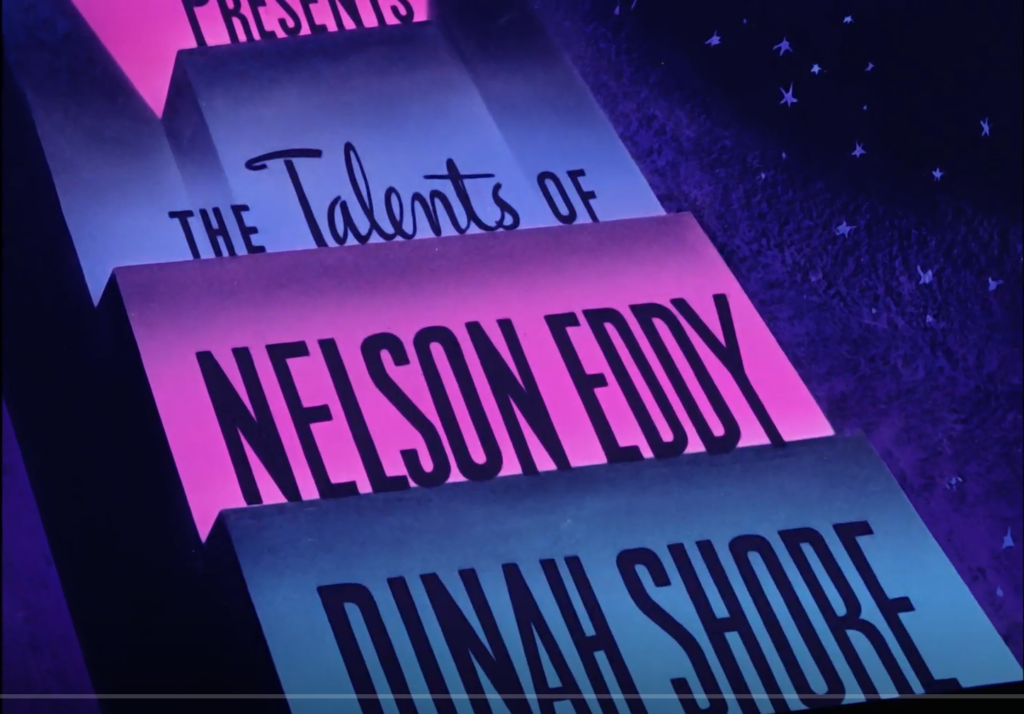
This brings us to something interesting about the post-Fantasia Disney anim-anthologies. They’re full of big-name stars to an almost Dreamworks-ian extent. I kind of enjoy this aspect of them. It gives you some idea of who was popular back then, or, more accurately, who Disney believed was popular then, or, even more accurately, who was popular and willing to work with Disney. It can come across as a little desperate at times though.
The rest of the credits appear as posters inside the theater. Then the doors to the concert hall open and a pamphlet fills the screen, explaining that this will be “a musical fantasy in ten parts.” This brings us to one, I repeat, one area in which Make Mine Music improves on Fantasia. Each segment is introduced with a rather beautiful placard briefly explaining what kind of piece it is going to be and what talent it will feature. This is much more economical than Deems Taylor’s dry and lengthy verbal intros.
The Martins and the Coys sung by The King’s Men
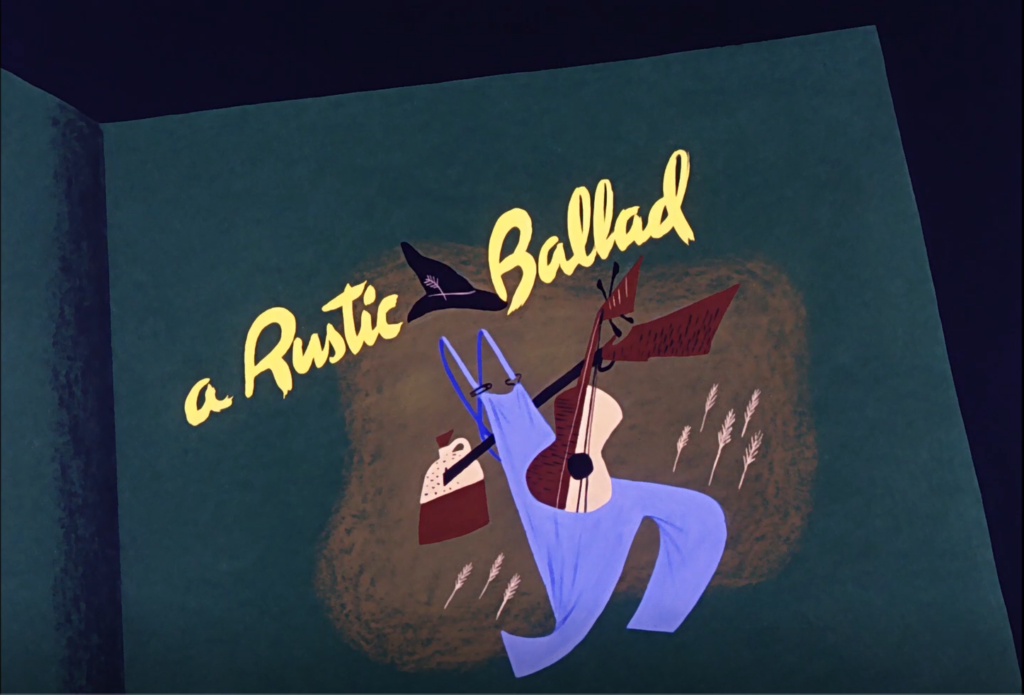
When this movie was first released on VHS/DVD, this opening short about a pair of feuding families in the Appalachian Mountains was omitted and it might be the reason it’s currently not on Disney+. Depending on whom you ask, this was either because of its offensive “hillbilly” stereotypes or because of its cartoony gun violence. While I certainly don’t blame anyone from Appalachia for being offended by the cartoon, I’m rather baffled by the first possibility since Disney continues to release old movies containing offensive stereotypes of groups with far more powerful lobbies behind them.[3]This is the last time I’m going to mention ethnic stereotypes in this series. I’ve written about the topic in previous posts and the average adult knows enough to expect outdated … Continue reading The second possibility makes a little more sense but not much. I mean, this kind of thing is pretty common in cartoons of the era and even the ensuing decades and I don’t know how many easily influenced children are going to be attracted to Make Mine Music anyway. It’s one of the few Disney anim-anthologies to feature neither Mickey, Donald nor Goofy.
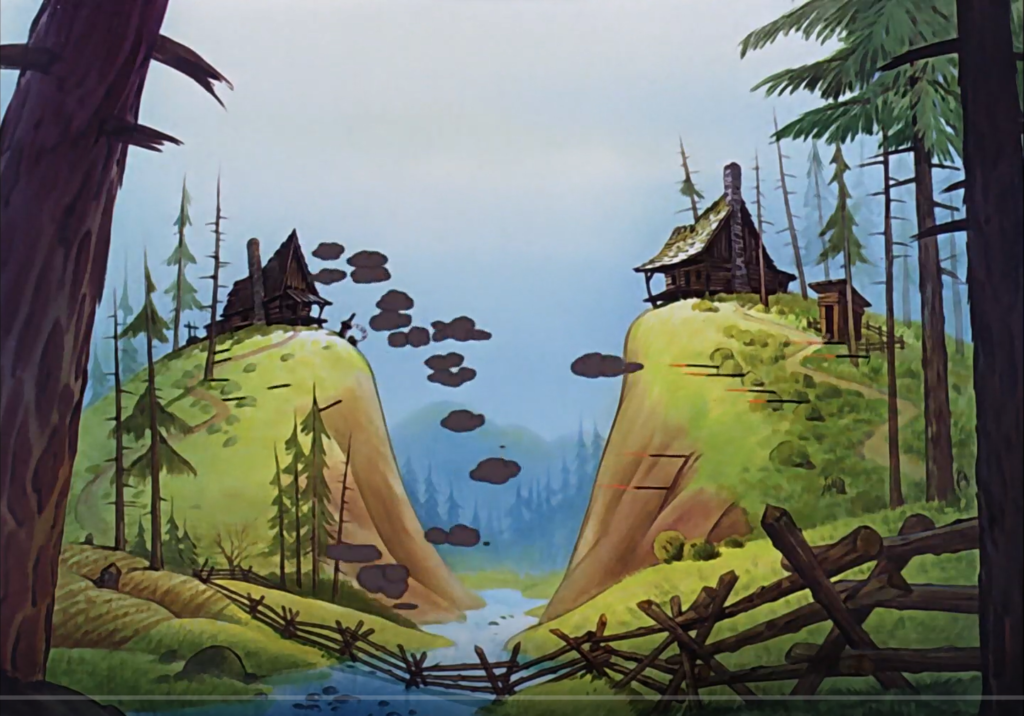
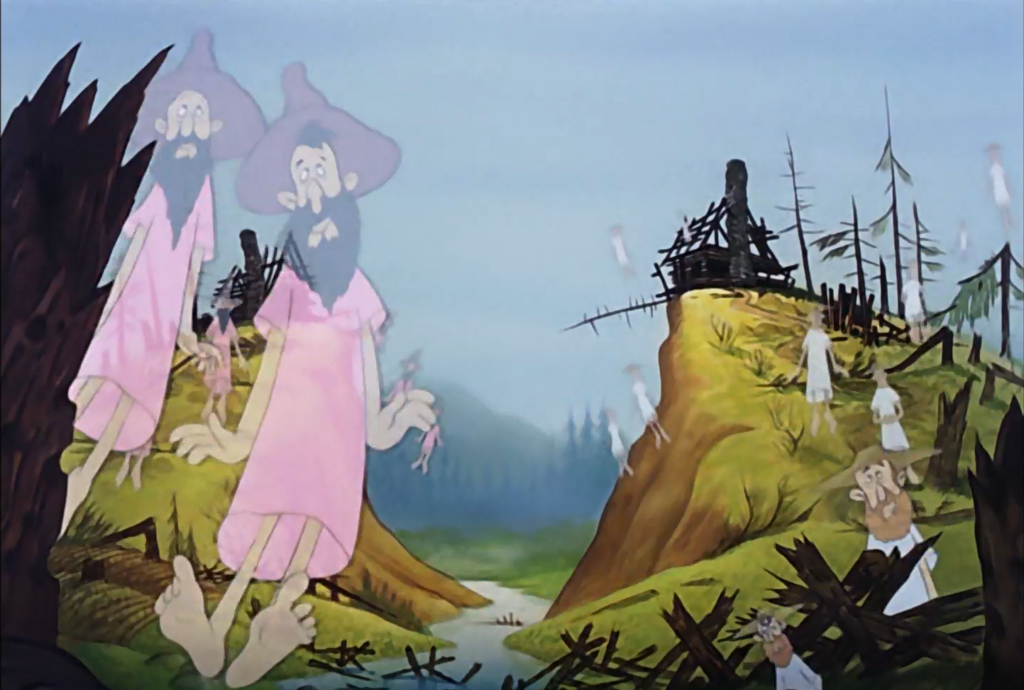
We’re clearly a long way from Fantasia with this first section and that’s not a compliment. Both the backgrounds and the simply cartoony character designs are very bland. But, hey, it’s not like this part is trying to be Fantasia. It’s trying to be funny and, well, it’s not unfunny. I can’t say it’s really hilarious either. Mildly diverting is a fair description.
Blue Bayou sung by the Ken Darby Chorus

This segment was actually something cut from Fantasia. You can tell because it’s so beautiful.


You can also tell because…well, as with several of the Fantasia segments, not much happens. Now I will defend the “boring” parts of Fantasia on the grounds of the wondrous subject matter they contain. (Fairies, dinosaurs, centaurs, earthquakes, volcanoes, winged horses, weirdly sexy goldfish.) Here we’ve just got a lovely lagoon and some cranes.[4]Or storks? I can’t tell the difference. Maybe it would have worked with the composition originally intended for it: Claire de Lune from Claude Debussy’s Suite bergamasque. The song we get, Blue Bayou, is indeed lovely, but it’s obviously a lullaby. I guess that’s not the worst thing. Some people do fall asleep in the cinema or in front of the TV and enjoy doing so. It’s not usually the content creators’ intent though.
All the Cats Join In performed by Benny Goodman and his Orchestra

The beginning of this one cleverly fools the viewer into thinking it’s going to be about actual cats when the title really refers to cats in colloquial sense.[5]Sorry for spoiling that punchline, but it’s impossible not to do so while explaining this short. A bunch of teenagers go hang out at a malt shop and dance to the jukebox’s music. The setting and characters are all portrayed as drawings in a sketch pad that come to life and sometimes move a little fast for the unseen artist’s pencil. For example, a car speeds off before it’s done being drawn and the pencil has to race ahead to do the road.[6]You may recall Saludos Amigos did some of the same thing. Chuck Jones’s 1953 cartoon, Duck Amuck, would have the most fun with the premise.



The art style is even more simplistic than that of The Martins and the Coys but this one’s a lot funnier and more energetic. It probably helps that the song is better.


Without You sung by Andy Russell

Then we get a constantly shifting series of images that change to reflect the lyrics of a sad song about an absent girlfriend. It’s quite beautiful, easily my favorite of the really artsy segments of Make Mine Music.



Casey at the Bat read by Jerry Colonna[7]Fans of old Disney movies may recognize radio performer Colonna as the voice of the March Hare from Alice in Wonderland.

This one’s easily the least musical of the shorts. There’s a bit of a song (Casey, the Pride of Them All), but it’s basically a cartoon adaptation of Ernest Thayer’s classic poem about pride going before a fall on the baseball field. However little it fits in with the rest of the movie though, it’s one of the best bits, featuring some of the funniest sight gags in the whole film if not the funniest period. I especially love the overelaborate sneer of Casey’s lip.[8]In 1954, Disney would actually do a sequel cartoon, Casey Bats Again in which the disgraced athlete hopes to father a son but is disappointed to sire nine daughters. Before you get mad, the girls … Continue reading



Two Silhouettes sung by Dinah Shore

This short is basically two rotoscoped ballet dancers (David Lichine and Tania Riabouchinskaya) performing in silhouette against an animated backdrop. That backdrop is very beautiful but, sheesh, who had this lame idea?



It should be obvious at this point that Make Mine Music has had a very particular pattern thus far. First, we get a visually unappealing but engaging comedic cartoon. Then we get a slow and sleepy but eye-catching artistically ambitious short. While Fantasia definitely had a variety of moods, I can see all the shorts in it as having the same target audience. On the other hand, I can’t imagine the viewer who gets a kick out of All Cats Join In as loving Without You or vice versa, not right afterwards anyway. I know I praised Make Mine Music for not wasting a lot of time on introductory stuff like Fantasia did, but maybe longer breaks between different episodes would have given viewers time to change gears. As it is, not only do you have to get in a specific mood to watch the movie, but you also have to get in two completely different moods at the same time.
The reason for this is probably that many of the shorts weren’t originally intended to be in the same movie and were randomly thrown together at the last minute. Yet this weird yoyo rhythm is so overt that I can’t help thinking it was intentional. Fortunately, its abandoned from this point on and while not all of the remaining segments are great, they all find a happy medium between the artistic and the entertaining. Like this next one for instance.
Prokofiev’s Peter and the Wolf

I’ve heard that this short was originally conceived as part of Fantasia. While its take on the classical composition isn’t as creative as the ones in that movie, it’s probably my favorite part of Make Mine Music. Maybe not quite as funny as Casey at the Bat or as visually stunning as the artier ones, but more satisfying. The characters of Peter, his grandfather, Sasha the bird, Sonya the duck and Ivan the cat are all highly amusing to watch. I’d expected the wolf to be comic too but he’s actually kind of terrifying.

I think that decision works wonderfully, making for a cartoon that is both funny and very suspenseful.

As with Pablo the Penguin’s short in Three Caballeros, the only words spoken in this are by Sterling Holloway’s dryly humorous narrator. Again, I’m not sure if narration was necessary at all since the story unfolds so clearly, but it has its moments.


After You’ve Gone performed by the Goodman Quartet

If you’re familiar with such surreal animated scenes as, say, Pink Elephants on Parade from Dumbo, you’ve seen this short about constantly shapeshifting musical instruments done better. But it benefits from the virtue of brevity.


Johnny Fedora and Alice Bluebonnet sung by the Andrews Sisters

This one tells the story of two hats in a department store who fall in love but are tragically separated.

The various hats are anthropomorphized in some clever ways. I especially admire a scene where a bar brawl is portrayed as a fight between the brawlers’ headgear.


As this suggests, Johnny’s search for Alice gets pretty dark and dramatic. I kind of like that about this cartoon.


On the whole, one of the better sections though I can’t shake the feeling it had potential up to which it didn’t live.[9]In 2013, Pixar released The Blue Umbrella, a short with a similar premise that while less dark, ended up being more emotional due to better chemistry between the leads.
The Whale Who Wanted to Sing at the Met featuring Nelson Eddy

The final short is about Willie, a whale who can sing opera in tenor, baritone and bass. An impresario called Tetti Tatti reads about this in the paper and guesses that a singer is trapped inside the animal. He sets out to harpoon Willie and get his hands on this incredible new talent. When Willie sees a newspaper clipping about the expedition, he happily assumes that he is the talent Tetti Tatti wants to discover. I wouldn’t call the ensuing story particularly engaging but it is interestingly weird. Nelson Eddy sings and speaks for all the characters and it’s a good showcase for his talent.

Remember what I wrote about how Fantasia represented a time when the Disney brand was less set in stone and they could be a little depressing? Well, the same could be said of the tragic end to this segment, which isn’t called an opera pathetique for no reason. And since it’s the last one, by extension the whole movie ends tragically. (At least Fantasia made sure its last piece was an uplifting one.)

As a matter of fact, of all the narrative shorts only Peter and the Wolf and Johnny Fedora and Alice Bluebonnet have really happy endings, though I wouldn’t call the conclusions of The Martins and the Coys or Casey at the Bat sad so much as cynically humorous. Couple that with the sadness of Without You and the grim middle section of Johnny Fedora and you’ve got one of the least cheery Disney movies out there. If Make Mine Music has some kind of connective tissue, maybe that’s it, though it kind of gives the lie to the title song’s lyrics, “Music will play the shadows away when everything seems to go wrong…”
Melody Time (1948)
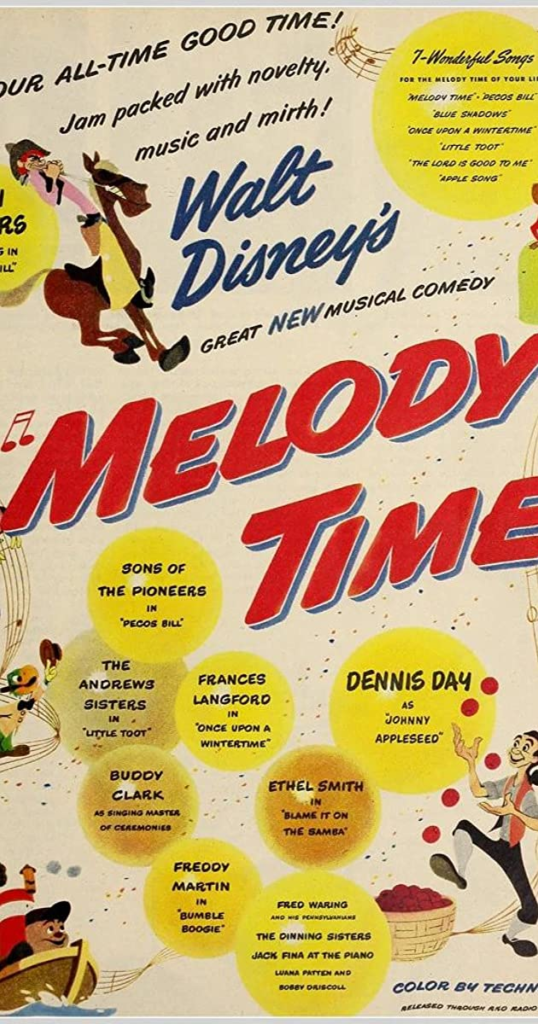
The second “poor man’s Fantasia”[10]Which arguably isn’t any more driven by music than Disney movies generally were back then but, hey, they had to title it something. also opens by flexing its starry cast. I kind of hate myself for saying that because I kind of love these opening credits but the description isn’t inaccurate. We begin with a stack of sheet music on a music stand and as we flip through it, we’re shown the names of Melody Time‘s big stars with the corresponding songs they sing or perform in it.

Then we move to an easel. A paintbrush paints a theatre and a dapper theater mask voiced by Buddy Clark who serves as our master of ceremonies. He introduces each segment, half the time in rhyme, and I must say he’s a lot more fun than Deems Taylor. The brush also creates a trio of other masks that serve as female backup singers but sadly I can’t find who voiced them.

Anyway, on with the show.
Once Upon a Wintertime Sung by Frances Langford
This song is set to a vignette of a pair of human sweethearts who go on a sleigh ride and then ice skate accompanied by a rabbit couple. It’s all very warm, cozy and nostalgic feeling.

At least that’s how it starts out. Later, it becomes quite dark and suspenseful as the ice breaks and the lovers are imperiled.


As with many animated Disney movies from the 1940s and 50s, the backgrounds were done by the wonderful Mary Blair, but what’s unusual is that the characters look like they were done by her too. Well, the animals do anyway; the humans are pretty standard. I don’t mind that this wasn’t the norm at Disney. As much as I love her backgrounds, Blair’s rather expressionless characters wouldn’t have animated well. But the complete Mary Blair-ness of this short makes it something of a must-see for her fans.
Bumble Boogie performed by Freddy Martin and his Orchestra
The music for this one is actually a swing-jazz variation Rimsky-Korsakov’s Flight of the Bumblebee. The visuals consist of a bee being menaced by piano keys. It starts out pretty slow but becomes much more entertaining as the artists find new ways to anthropomorphize piano keys and it’s smart enough not to outstay its welcome.


Basically, this is what After You’ve Gone from Make Mine Music should have been.
The Legend of Johnny Appleseed portrayed by Dennis Day
Day narrates and does all the voices in this short biography of the American folk hero.[11]I know that John Chapman was a real person, but this is clearly the legendary version. I’ve read some people praise it, but I find it pretty dull myself. There’s not much in the way of humor or action. I understand that this cartoon is trying to celebrating a peaceful nonviolent hero and that’s great, but even stories about heroic pacifists typically involve some kind of conflict or struggle. Here Johnny, after being given a peptalk by his guardian angel, sets off on his mission and…basically accomplishes it without much fuss. Even before he befriends all the wild animals, none of them try to attack him. They just wait for the local skunk to scare him away.

Still, Mary Blair’s artwork makes this worth a look and it deserves credit for featuring the only song from Melody Time to have a life outside of it, The Lord’s Been Good to Me.



Little Toot sung by the Andrew Sisters
This adaptation of the children’s story by Hardie Gramatky is about a mischievous little tugboat whose rare attempt at being helpful causes a huge accident.

This gets Little Toot banished from the harbor, but he redeems himself by helping a distressed ship.

There’s nothing particularly wrong with the cartoon but there’s nothing that stands out as brilliant either. My favorite aspects are how the waves and lightning during a storm appear as menacing trying to grab Little Toot and that’s something you see in other Disney cartoons of the era.[12]I remember when I was three or four years old, watching Sing Me a Story With Belle on Playhouse Disney, which repackaged old Disney cartoons with new songs and tried to use them to teach moral … Continue reading

Trees performed by Fred Waring and his Pennsylvanians
Joyce Kilmer’s classic poem is set to dramatic music by Oscar Rasbach. The visuals for this segment are breathtakingly beautiful, making it the most visually impressive part of Melody Time. I kind of hate to say that since it doesn’t look like Mary Blair’s work. The only other artist credited for color and styling is Claude Coats but the other backdrops in this movie that don’t scream, “Mary Blair,” are so forgettable that I’m inclined to credit these to her anyway.




Blame It on the Samba featuring Ethel Smith and the Dinning Sisters
Donald Duck and Jose Carioca are back for another encore. Here they’re depressed (possibly because they read my last blog post) and stop at Cafe do Samba where their waiter, the Aracuan bird slips them a “little musical cocktail” with “a dash of the samba.” This is basically leftovers from The Three Caballeros but really good leftovers. Frankly, I’d much rather rewatch this than that movie. Maybe it’s because the surreal visual gags are funnier. Maybe it’s because the song is catchier than anything in The Three Caballeros with the possible exception of that film’s title track.


Pecos Bill performed by Roy Rogers and the Songs of the Pioneers
The finale is actually two segments for the price of one, not unlike Fantasia‘s Night on Bald Mountain/Ave Maria combo. “Any story about Pecos is bound to be strong medicine,” says Buddy Clark, “maybe it’s best to sashay into it gently.” Thus, we get some animated footage of a desert at night while the soft song, Blue Shadows on the Trail plays. It’s no Trees but still very pleasant.


Eventually, we find the singers, Roy Rogers and the Sons of the Pioneers gathered around a campfire with Roy’s horse, Trigger, and some children including Disney’s child stars, Bobby Driscoll and Luanna Patten. The melancholy noise of coyotes howling inspires them to tell the story of American tall tale hero, Pecos Bill. (When told that Bill’s horse was named “Widowmaker,” Patten laughs and say, “that’s a funny name,” which is sort of disturbing.)

The raucous cartoon that ensues might be even more fun than Blame It on the Samba. The “just so story” aspects make for a host of fun visuals like Bill digging the Rio Grande, painting the painted desert (sort of) and unintentionally scattering gold in California. And the song, Yippee-I-Yay, might just be the catchiest in all of Melody Time.



While I enjoy this one much more than I do Johnny Appleseed, I can’t help but wonder if they should have switched places. Given how Johnny emphasizes the differences between its lead and the stereotypically violent and macho hero of the American frontier, it feels anticlimactic to go from him to a “normal” one. Who knows? Maybe if I had Bill fresh in my memory when watching Johnny, the contrast would make his story more interesting. Both shorts incidentally continue the trend from previous Disney anim-anthologies of not every story having a happy ending, though it’s up for debate which one is the less happy of the two.[13]For those of you don’t mind them being spoiled, Johnny Appleseed dies but gets to continue his mission of planting apple trees in Heaven while the last we see of Pecos Bill, he’s alive … Continue reading
Conclusion
It’s hard for me to say which of these I’m more likely to recommend. The parts of Make Mine Music that I love, I love more than my favorite parts of Melody Time. At any rate, they’re more interesting if I may make the distinction between interesting and good. But, on the other hand, Melody Time has a much smoother flow to it and is more cohesive. I feel safer recommending it to my friends who aren’t necessarily interested in animation the same way I am. They’d still probably be a bit bewildered as to why I recommended it, but they’d be more likely to forgive me. Obviously, neither counts as the best animated thing that Disney ever produced, but in some ways, they’re the most fascinating.

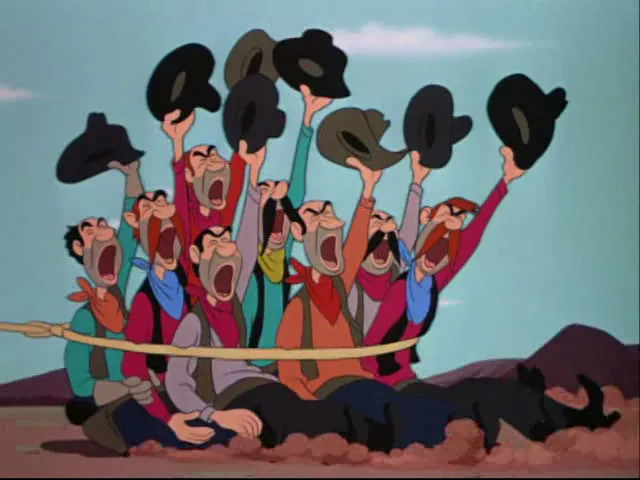
To Be Continued
References
| ↑1 | Perhaps I should have tried to explain this in the last post, but I also had to explain about the Good Neighbor policy thing, and this isn’t supposed to be a blog about history. I thought it would be a bit much. |
|---|---|
| ↑2 | Don’t ask me what the title means. |
| ↑3 | This is the last time I’m going to mention ethnic stereotypes in this series. I’ve written about the topic in previous posts and the average adult knows enough to expect outdated stereotypes from old cartoons. |
| ↑4 | Or storks? I can’t tell the difference. |
| ↑5 | Sorry for spoiling that punchline, but it’s impossible not to do so while explaining this short. |
| ↑6 | You may recall Saludos Amigos did some of the same thing. Chuck Jones’s 1953 cartoon, Duck Amuck, would have the most fun with the premise. |
| ↑7 | Fans of old Disney movies may recognize radio performer Colonna as the voice of the March Hare from Alice in Wonderland. |
| ↑8 | In 1954, Disney would actually do a sequel cartoon, Casey Bats Again in which the disgraced athlete hopes to father a son but is disappointed to sire nine daughters. Before you get mad, the girls surprise their father by being natural baseball players and form a team. Despite not being based on a classic poem, it’s a fairly worthy follow-up. |
| ↑9 | In 2013, Pixar released The Blue Umbrella, a short with a similar premise that while less dark, ended up being more emotional due to better chemistry between the leads. |
| ↑10 | Which arguably isn’t any more driven by music than Disney movies generally were back then but, hey, they had to title it something. |
| ↑11 | I know that John Chapman was a real person, but this is clearly the legendary version. |
| ↑12 | I remember when I was three or four years old, watching Sing Me a Story With Belle on Playhouse Disney, which repackaged old Disney cartoons with new songs and tried to use them to teach moral lessons or promote literacy. Little Toot was one of the ones that got the treatment and while the show was aimed at the youngest viewers and the Disney anim-anthologies generally tried to entertain multiple generations, I think the song they came up with for it was catchier than the one the Andrews Sisters sang. You can decide for yourself. |
| ↑13 | For those of you don’t mind them being spoiled, Johnny Appleseed dies but gets to continue his mission of planting apple trees in Heaven while the last we see of Pecos Bill, he’s alive but haunted by the memory of a lost love.
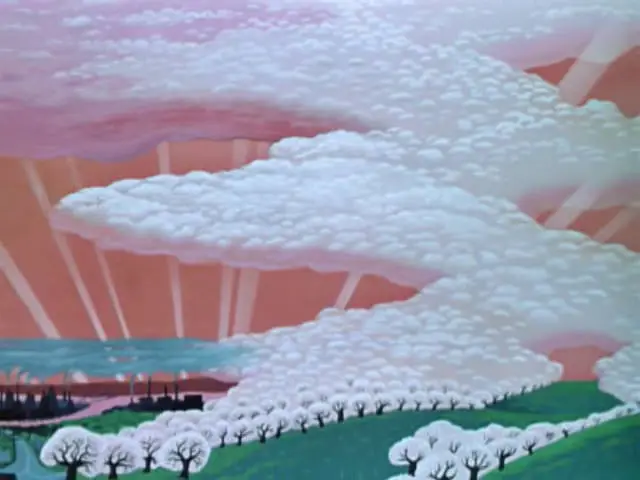 https://theadaptationstation.com/wp-content/uploads/2023/02/melody-time-disneyscreencaps.com-3553-2-300x225.webp 300w" sizes="(max-width: 640px) 100vw, 640px" /> https://theadaptationstation.com/wp-content/uploads/2023/02/melody-time-disneyscreencaps.com-3553-2-300x225.webp 300w" sizes="(max-width: 640px) 100vw, 640px" />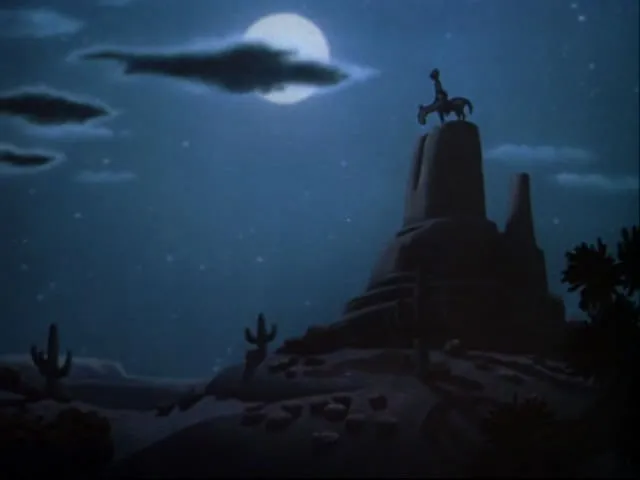 https://theadaptationstation.com/wp-content/uploads/2023/02/melody-time-disneyscreencaps.com-8310-1-300x225.webp 300w" sizes="(max-width: 640px) 100vw, 640px" /> https://theadaptationstation.com/wp-content/uploads/2023/02/melody-time-disneyscreencaps.com-8310-1-300x225.webp 300w" sizes="(max-width: 640px) 100vw, 640px" /> |
